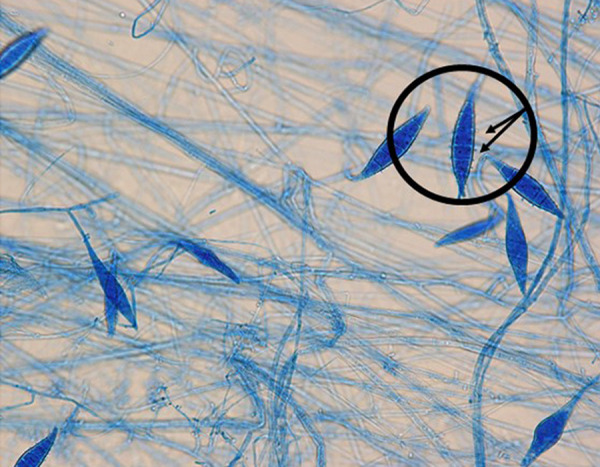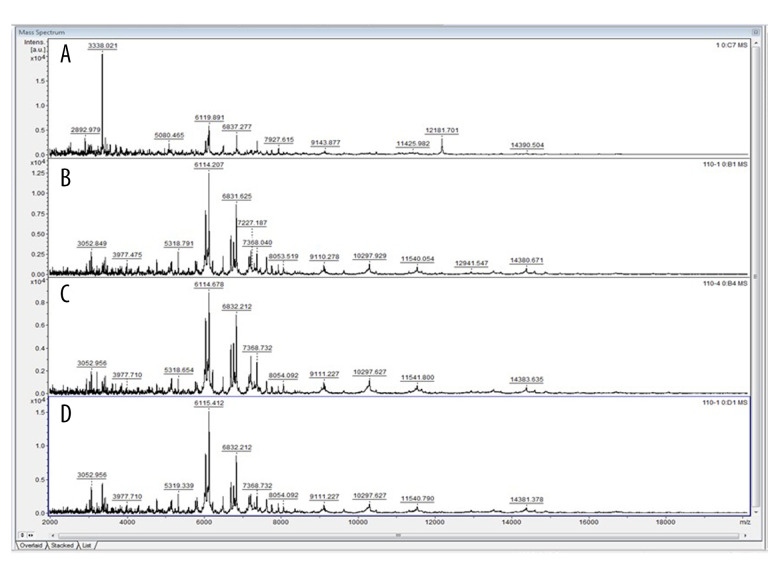Abstract
Free full text

A Household Microsporum canis Dermatophytosis Suggested by Matrix-Assisted Laser Desorption/ Ionization Time-Of-Flight Mass Spectrometry Analysis
Abstract
Case series
Patients: Female, 4-year-old • her family (father, mother, sister)
Final Diagnosis: Microsporum canis dermatophytosis
Symptoms: Itiching
Medication: —
Clinical Procedure: Time-of-flight mass spectrometry (TOF-MS)
Specialty: Infectious Diseases
Objective:
Unknown ethiology
Background:
Microsporum canis is a pathogenic dermatophyte that usually colonizes animals, and secondary infection of humans comes from pets. The infected patients show hair loss with erythema and are diagnosed as having dermatophytosis, but the transmission routes of M. canis from animals to others are sometimes unclear, although they are critical to the treatment of patients and infection control. To identify the pathogens and the transmission routes, morphological observations by microscopes and conventional polymerase chain reaction (PCR) have been used; however, matrix-assisted laser desorption/ionization time-of-flight mass spectrometry (MALDI-TOF MS) has recently become a useful tool.
Case Reports:
A 4-year-old girl presented with pruritic, erythematous lesions on the head with alopecia. The dermatologists diagnosed dermatophytosis caused by fungal infection, and M. canis was suspected as the pathogen because of the morphologic characteristics. All of her family members subsequently showed similar hair findings and symptoms. The growth of M. canis was also observed in serial cultures, and all strains were confirmed to be identical, but different from the standard strain on MALDI-TOF MS. In this household infection case, abandoned cats were considered to be the origin of M. canis transmission, and the family members finally improved following oral administration of antifungal agents.
Conclusions:
M. canis should be carefully investigated as the causative pathogen of dermatophytosis secondary to household infection. MALDI-TOF MS appears to be an excellent tool to confirm the transmission routes of the fungal pathogens among infected patients.
Background
Microsporum canis is a pathogenic and zoophilic dermatophyte that typically colonizes the outer surface of an animal’s body. M. canis usually infects humans as a secondary infection from pets, including dogs and cats [1,2] M. canis infection of humans induces tinea capitis and tinea corporis, particularly in children, and its dermatophytosis is known as Celsus kerion [1–4]. In general, it shows the typical pathophysiological signs and symptoms, and M. canis invasion of hair and skin is sometimes observed on the head of the patients [5]. Therefore, infection with M. canis is usually associated with alopecia, and infection has been diagnosed by isolation of fungus, which has characteristic hyphae or arthroconidia, from the patients’ hair lesions [6,7]. In asymptomatic cases, both Wood’s lamp examination and microscopic analyses of suspected areas are highly recommended.
However, these microscopic identifications were affected by the skills and experiences of the microbiologists; therefore, molecular-based detection systems, such as polymerase chain reaction (PCR) and PCR-fingerprinting, have been developed to detect the fungal pathogens of dermatophytosis and their transmission routes [8,9].
Furthermore, in the present case, household infection by M. canis was confirmed by isolation of identical, but different from the standard strain, fungi from the father, mother, and sister by the more novel proteomic detection system, such as matrix-assisted laser desorption/ionization time-of-flight mass spectrometry (MALDI-TOF MS).
The analysis of this case was approved by the Committee for Clinical Scientific Research of Tohoku Medical and Pharmaceutical University Hospital on April 11, 2019 (No. ID 2019-2-014), and the patients provided written informed consent for use of their culture specimens, although the samples were collected as part of routine laboratory analyses.
Case Reports
A 4-year-old girl visited the dermatology clinic because of itching of the head, for which bacterial infection with some allergic reaction was suspected. She received oral antibiotics and anti-allergy drugs, but did not improve after 2 weeks of drug therapy. Her symptoms became severe, and erythema and slight hair loss appeared.
The patient consulted our hospital, where dermatophytosis as a result of fungal infection was suspected. Direct microscopy of her hair and purulent secretions showed morphological characteristics of septated hyphae and spindle-shaped macroconidia with an asymmetrical apical knob (Figure 1). Based on these, M. canis was suspected as the pathogen, and the patient improved after being given the oral antifungal agent itraconazole 50 mg/day for 1 month.

Light microscopy findings. Lactophenol-Cotton Blue staining of the species grown from the patient’s skin. Characteristic ship-like and spindle-shaped macroconidia with granular spikes on the surface are found (arrows and circles, ×1000).
However, within 1 week after her first visit to our hospital, her family members, including her father, mother, and 10-year-old older sister, developed similar symptoms and hair findings. All of these family members were asked to visit our hospital; the fungus in each case had similar characteristics that were suggestive of M. canis on a potato dextrose agar with Chloramphenicol Plate (Nissui Co. Ltd., Tokyo, Japan) developed after 10–14 days at 30°C. The fungi were different from the standard strain, but they were confirmed to be identical by MALDI-TOF MS (Figure 2). The family also received the appropriate amount of itraconazole dependent on body weight and subsequently improved.

Mass spectral analysis findings. The findings for Microsporum canis ATCC standard strain (A) are different, but matched peaks are seen in the M. canis species isolated from the father (B), mother (C), and sister (D).
This family had no pets, but the initial patient, the 4-year-old girl who first showed symptoms, would usually feed abandoned cats near the park. These abandoned cats were considered the origin of the M. canis transmission in this household infection case.
Discussion
Hair loss with erythema caused by M. canis may sometimes be associated with exposure to animals, but an outbreak with household transmission confirmed by MALDI-TOF MS was described in this report. The natural reservoir of M. canis is dogs and cats, and secondary infection in humans causes tinea capitis and tinea corporis. These hair and skin lesions have been observed in severe cases when M. canis infects immunocom-promised hosts [5–7]. However, M. canis has been reported as one of the transmitted pathogens in hospitals and some facilities, including military bases [10–12].
In a large outbreak that caused symptomatic infections in 53 of 502 staff members on a military base, logistic regression analysis showed that female sex and contact with cats on the base were risk factors. Multiple exposures to stray cats were suggested to have caused infection of mainly young female soldiers who assumed guard duties, whereas the other individuals were infected by person-to-person transmission. The genotype of the isolated M. canis was identical in 4 cats and 4 patients, but different in 2 patients [10]. Among the developing countries, local socio-economic conditions and poor cultural practices can influence the prevalence and outbreak of the particular infection in the given areas [11]. An outbreak of M canis infection that affected 12 persons in 2 elementary schools was also reported, and the contact with adopted stray cats at a birthday party was suggested as the most probable source of the outbreak [12].
In this present case, the origin was not directly identified, but the history of the index case taking care of abandoned cats in a nearby park was likely the clue to the cause. These abandoned cats were very likely the reservoir of the M. canis and the origin of transmission to the family. M. canis has a characteristic morphology and produces septate hyphae and macro-conidia that are spindle-shaped and have asymmetrical, apical knobs [3,4,6,7]. Morphological identification is straightforward for isolates that form the typical and characteristic features. However, accurate identification of these structures relies on the experience of the staff, and in daily practice the mycology laboratory is often confronted with strains that present with atypical colony morphology and physiological tests, conidia, or sterile growth. In comparison, molecular/proteomic methods are faster and less dependent on staff workload and expertise [3,9].
Recently, MALDI-TOF MS was suggested to be a reliable, rapid, and effective method for the routine identification of fungi, including dermatophytes, and 100% of M. canis were identified [13–15]. In addition, MALDI-TOF MS has been shown to be cost effective, with limited expenses for material and reagents, and it has a considerably shorter turnaround time compared with that of routine culture or even molecular identification [16–18]. Some reports on dermatophytes showed that MALDI-TOF MS led to low consumable costs and results that can be provided within 3–4 days after culture, whereas molecular analyses, in particular DNA sequencing, were expensive and time consuming [8,14,17]. We expect that MALDI-TOF MS will become a very effective tool for not only identification of pathological fungi, but also for the investigation of fungus transmission in nosocomial and household settings.
Conclusions
In conclusion, a case of household infection of M. canis in a child who fed abandoned cats was described. M. canis should be carefully investigated and treated as a causative pathogen of dermatophytosis secondary to household infection. In the present case, MALDI-TOF MS was shown to be a very effective tool to identify the infection route to confirm the transmission of a pathological fungus among the infected patients and help select appropriate treatment for the affected family members.
References:
Articles from The American Journal of Case Reports are provided here courtesy of International Scientific Information, Inc.
Full text links
Read article at publisher's site: https://doi.org/10.12659/ajcr.930713
Read article for free, from open access legal sources, via Unpaywall:
https://www.ncbi.nlm.nih.gov/pmc/articles/PMC8033217
Citations & impact
Impact metrics
Article citations
Matrix-assisted laser desorption ionization-time-of-flight mass spectrometry in veterinary medicine: Recent advances (2019-present).
Vet World, 15(11):2623-2657, 21 Nov 2022
Cited by: 7 articles | PMID: 36590115 | PMCID: PMC9798047
Review Free full text in Europe PMC
Similar Articles
To arrive at the top five similar articles we use a word-weighted algorithm to compare words from the Title and Abstract of each citation.
Towards a rapid identification and a novel proteomic analysis for dermatophytes from human and animal dermatophytosis.
Mycoses, 62(12):1116-1126, 16 Oct 2019
Cited by: 9 articles | PMID: 31493312
Use of a commercial qPCR assay in 52 high risk shelter cats for disease identification of dermatophytosis and mycological cure.
Vet Dermatol, 29(1):66-e26, 18 Aug 2017
Cited by: 2 articles | PMID: 28833730
Two novel species of Arthroderma isolated from domestic cats with dermatophytosis in the United States.
Med Mycol, 60(2):myac001, 01 Feb 2022
Cited by: 2 articles | PMID: 34999826 | PMCID: PMC8808258
Trichophyton species of Arthroderma benhamiae - a new infectious agent in dermatology.
J Dtsch Dermatol Ges, 12(7):571-581, 01 Jul 2014
Cited by: 45 articles | PMID: 24981469
Review




